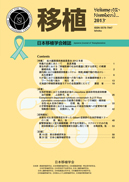Volume 52, Issue 1
Displaying 1-14 of 14 articles from this issue
- |<
- <
- 1
- >
- >|
-
2017Volume 52Issue 1 Pages 001-006
Published: March 10, 2017
Released on J-STAGE: April 04, 2017
Download PDF (415K) -
2017Volume 52Issue 1 Pages 007-012
Published: March 10, 2017
Released on J-STAGE: April 04, 2017
Download PDF (1553K) -
2017Volume 52Issue 1 Pages 013-019
Published: March 10, 2017
Released on J-STAGE: April 04, 2017
Download PDF (5189K) -
2017Volume 52Issue 1 Pages 020-023
Published: March 10, 2017
Released on J-STAGE: April 04, 2017
Download PDF (253K) -
2017Volume 52Issue 1 Pages 024-030
Published: March 10, 2017
Released on J-STAGE: April 04, 2017
Download PDF (4000K) -
2017Volume 52Issue 1 Pages 031-037
Published: March 10, 2017
Released on J-STAGE: April 04, 2017
Download PDF (371K)
Original Article
-
2017Volume 52Issue 1 Pages 038-050
Published: March 10, 2017
Released on J-STAGE: April 04, 2017
Download PDF (2959K) -
2017Volume 52Issue 1 Pages 051-059
Published: March 10, 2017
Released on J-STAGE: April 04, 2017
Download PDF (350K)
Case Report
-
2017Volume 52Issue 1 Pages 060-066
Published: March 10, 2017
Released on J-STAGE: April 04, 2017
Download PDF (1639K) -
2017Volume 52Issue 1 Pages 067-072
Published: March 10, 2017
Released on J-STAGE: April 04, 2017
Download PDF (11209K) -
2017Volume 52Issue 1 Pages 073-080
Published: March 10, 2017
Released on J-STAGE: April 04, 2017
Download PDF (9455K) -
2017Volume 52Issue 1 Pages 081-086
Published: March 10, 2017
Released on J-STAGE: April 04, 2017
Download PDF (478K)
-
2017Volume 52Issue 1 Pages 87-96
Published: 2017
Released on J-STAGE: April 04, 2017
Download PDF (615K)
-
2017Volume 52Issue 1 Pages 097-103
Published: March 10, 2017
Released on J-STAGE: April 04, 2017
Download PDF (459K)
- |<
- <
- 1
- >
- >|
